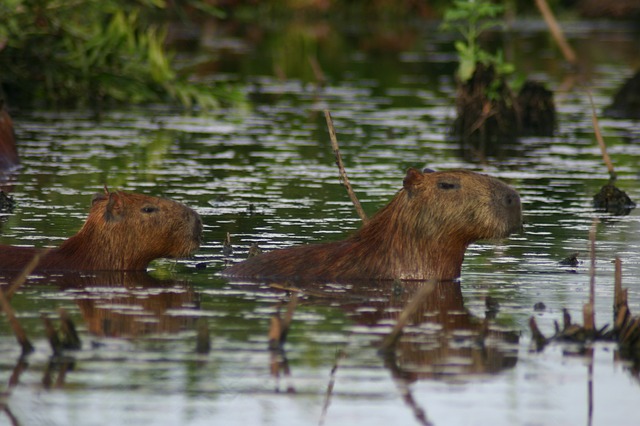Capybaras are remarkable swimmers, in fact they only live near a body of water. This is not very rare for rodents, but it is rare for a land animal of their size to be such prolific swimmers. They swim not only to clean themselves or to relax but also to eat aquatic plants, an important food source for capybaras in the wild. They are naturally great swimmers and while capybaras do not learn to swim as fast as other rodents such as beavers, their body is built to swim: their partly webbed toes are perfect for swimming, their claws are strong and short, and their fur is long and crisp, perfect for drying quickly.

Capybara Swim Speed
It is rare to see a capybara swim quickly unless they are chased by a predator, but they can in fact swim remarkably fast. A capybara can swim at a speed of up to 5 miles per hour (or 8 kmh). On average they swim slower than that but their body is well built for swimming fast. For comparison, an average kayak paddles at around 2-3 miles per hour.
How Much Time Do Capybaras Spend Swimming
As semi-aquatic animals, capybaras are able to spend a very long time in the water, on some days they will spend more time in the water than on land. They are able to swim while in the water, only their heads will be out.
Can Capybaras Breathe Underwater
Capybaras are known to be able to stay underwater for up to five minutes in order to evade predators. While they can hold their breath for this long, they can’t breathe while fully submerged in the water. However, due to their nostrils being on the pointy end of their head, they can have most of their bodies underwater while breathing outside. This is the way capybaras sleep while in the water so that their body is protected from larger predators that can’t swim.
Capybara Hot Springs
A video of capybaras chilling in hot springs made the rounds of the internet so the question arises – do capybaras prefer or seek hot springs? The answer is yes and no. The video in question was filmed in a Japanese zoo during winter. Capybaras don’t like the cold as they do not have winter in South America. They do not seek out hot springs but given that the hot spring is closer to the water from their native habitat, they will prefer it and will be more relaxed in warm water.
